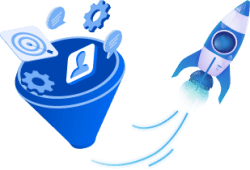How to grow your Shopify app to $100K MRR and beyond

I raised the biggest check for my startup through an elevator pitch. True story. A real elevator pitch. And, the whole ride was three floors up.
It was an evening function at the home of some foreign diplomat. A handful of entrepreneurs, I included, met a handful of investors. I had been bootstrapping my startup for nearly a year and a half then and getting to a point where I needed to get some funding soon.
The diplomat lived on the third floor of the building. As I walked into the lobby, an older man walked in as well. We nodded at each other and hit the elevator button. “Investor or Entrepreneur?”, I asked. “Investor”, he said. “Can I tell you about my startup?”, I asked. Just then the elevator arrived and the door opened. He pointed inside, smiled, and said “Here’s the elevator. Pitch me. “
I gave my quick explainer of what we do, “and”, I said, “we’re nearly at positive unit economics”.
That was enough for him to give me his card and ask me to set up a proper meeting. It turned out that he was a very prolific early-stage investor. We closed our seed round 3 months later, and he became my biggest, and, over time, favorite investor.
Most startups begin with negative unit economics. They spend more on acquiring customers than what they make from them. Some well-funded startups go very far exchanging rapid growth for model profitability. Amazon is an obvious example.
All startups, at one point, must reach positive unit economics.
Sequoia Capital says:
For a product to succeed over a long period of time, several conditions must be present: product-market fit, positive unit economics, and the ability to scale and grow
Actually, reaching positive unit economics gives you the ability to scale and grow. Once you extract more value from your users than they cost, you reach a virtuous cycle of reinvesting ever-growing marketing budgets on acquiring more and more new customers. You may need funding to cover the payback period and your overheads. But investors love startups that are at positive unit economics. Funding your payback period should not be an issue.
Reaching positive unit economics is a major milestone, but it doesn’t end there. Once you’re positive, you want your model to become more and more profitable. If your unit economics are better than your competitors’, you’re in a strong position to outgrow them and dominate your market.
While much has been written on how to measure unit economics and why reaching positive unit economics is important, surprisingly little has been written about how to get there.
This article lists and explains the drivers of unit economics. Each driver is broken down into tactics that you can use to drive your model into positive unit economics, and beyond, with links for further reading.

The “unit” in unit economics can be the user, customer, or product/service. It’s similar formulas, rearranged to show the chosen metric. We will use the most common unit, the customer.
How to calculate unit economics:
Unit economics= LTV – CAC
Lifetime Value (LTV) measures how much money you make from your average customer.
The Cost of Acquired Customer (CAC) measures how much it costs you to get a customer.
When LTV is bigger than CAC you’re making more from your customers than it costs you to get them. That means you’ve reached positive unit economics.
Positive Unit Economics: LTV>CAC
How to Calculate model profitability:
Model profitability is measured by ROI.
ROI= LTV/CAC
The higher the LTV and the lower the CAC, the higher the ROI
A startup whose LTV is $300 and CAC is $200 has ROI=$300/$200= 150%. You get a $1.50 for every $1 spent.
How to calculate LTV:
LTV is composed of the Average Order Size (AOV), Gross Margin (GM), and the number of Transactions (T).
LTV= AOV*GM*T
If we have a product that sells for $100 (AOV), has a 25% gross margin (GM), and the average customer makes 12 orders (T), LTV=$100*0.25*12=$300
How to calculate CAC:
CAC=Total marketing & direct selling costs /# of customers
Numeric example = $10,000 marketing spend, 50 sales
CAC= $10,000/50=$200
How to break down CAC:
It’s useful to break CAC into User Acquisition Cost (UAC) and Conversion Rate (CVR) because it allows you to assess and optimize each part separately.
CAC= user acquisition cost (UAC) / conversion rate (CVR)
UAC=Total marketing & direct selling costs /# of users
CVR=customers/#users
Numeric example (same as above): $10,000 marketing spend, 50 sales, 20,000 users
UAC=$10,000/20,000=$0.50. It costs $0.50/user
CVR=50/20,000= 1/400= 0.25%. One in 400, or 0.25% of users become customers
CAC=$0.50/0.25%=$0.5*400=$200

The LTV formula is all multiplications: AOV*GM*T. This means that whichever part you improve, the LTV improves by the same factor. Since you want maximum results and have limited resources, it makes sense to target the parts that have the biggest improvement potential first.
High impact tactics:
Medium impact tactics:
High impact tactics:
Medium impact tactics:
High impact tactics:
Medium impact tactics:
The high impact tactics for your LTV are a major price hike, vertical integration, improved onboarding, and reduced churn (for SaaS). These tactics are relevant in certain situations. In addition, there are many medium impact tactics you can deploy. Improving several medium-impact tactics adds up.

CAC is composed of the user acquisition cost and conversion rate. By separating them, we can try to optimize each one. Note though that the two are very much intertwined. If you reduce your user acquisition cost by bringing in cheap junk traffic, you’ll have difficulties converting. It’s often worthwhile to increase your user acquisition cost by acquiring more expensive traffic that converts well.
High impact tactics:
Medium impact tactics:
High impact tactics:
Medium impact tactics:

You can improve your unit economics by focusing on increasing your average order size, gross margin, the number of transactions from each customer, conversion rate, and by decreasing your user acquisition cost.
To get the biggest gains in lifetime value, you need to hike your prices, vertically integrate, dramatically improve onboarding or slash your churn.
To get the biggest cuts in CAC, you need to establish new traffic partnerships, nail your targeting, or optimize your conversion funnel.
There are a bunch of other tactics that give you moderate gains that add up.
A summary of these tactics, and more, is available in this google doc. Mapping all the relevant tactics is best done collaboratively. If you’d like to share additional tactics or good links, please post in the comments and I will add them to the spreadsheet.
How to grow your Shopify app to $100K MRR and beyond
Shopify app funnel optimization part 1: Shopify app store page to Shopify app install.
B2b SaaS: How we multiplied conversion rate by 16x and scaled to a $100M exit
Since 2018, we’ve been helping Shopify apps achieve exceptional growth.
Our team at Convert2x offers a comprehensive solution to scale your Shopify app:
– Grow organic and paid traffic
– Optimize your Shopify funnel
– Maximize monetization
Convert2x was founded by Boaz Lantsman, a repeat entrepreneur and conversion rate optimization expert. Since our inception, we have focused on Shopify apps, perfecting every aspect of scaling: from SEO and paid traffic acquisition through end-to-end funnel optimization that maximizes monetization.
Before founding Convert2x, Boaz led marketing at a B2B SaaS startup, where his strategies multiplied the conversion rate by 16x and increased sales by 7x, leading to the company’s acquisition by DocuSign for nearly $100 million. Following this success, Boaz co-founded RoutePerfect, a travel startup where he achieved a 12x increase in conversion rate and scaled the platform to 5 million users and $500K MRR.
In addition to his work at Convert2x, Boaz co-founded Prys, a breakthrough Shopify app growth platform (https://www.prys.io). Prys provides end-to-end attribution, showing which search terms and campaigns drive your revenues, and offering actionable insights to scale your Shopify app.
At Convert2x, we apply Boaz’s proven methodologies and our team’s extensive expertise to help Shopify apps thrive. Join us, and let’s grow your app to new heights.
































We help Shopify apps find and prioritize keywords, scale traffic with SEO and paid ads, maximize monetization, and optimize the Shopify app store page and post-install funnel.
I’ve worked with many consultants before, who are just in it to sign another client and make another dollar. Boaz is far from that type of person. There haven’t been many people in my career who I’ve worked with that “get it” quite like Boaz. He uses a data-driven approach and industry knowledge to provide strategies that work. He helped us optimize some areas of our business better than I could have imagined. I thought some of the projections he proposed to us were impossible, but we’ve actually outperformed these and are still on our way up. I couldn’t recommend Boaz more (unless you are a competitor, in which case he sucks…)